Let’s resume our tour of Rome
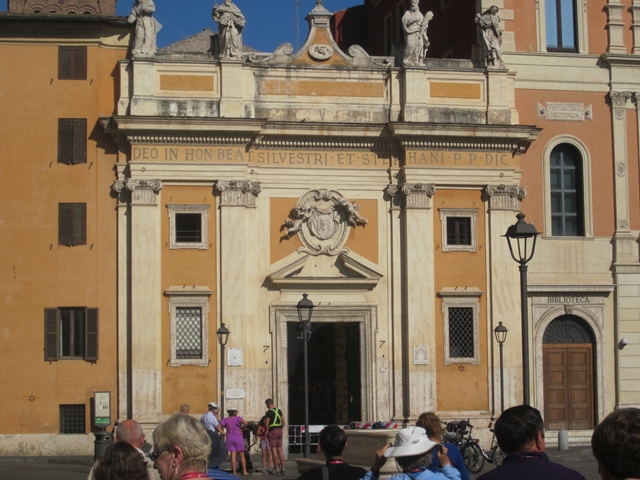 The Church of San Silvestro (Sylvester) lends its name to the square where this beautiful church is located. The church, also known as San Silvestro in Capite (head on?), boasts the head of Saint John the Baptist as a relic. We didn’t see his head here, but we did see Saint Catherine’s head in Siena, as you’ll see later. The authenticity of the head is uncertain, as the head of St John has also been venerated in other places -notably the great basilica of Damascus which is now the Umayyad Mosque.
The Church of San Silvestro (Sylvester) lends its name to the square where this beautiful church is located. The church, also known as San Silvestro in Capite (head on?), boasts the head of Saint John the Baptist as a relic. We didn’t see his head here, but we did see Saint Catherine’s head in Siena, as you’ll see later. The authenticity of the head is uncertain, as the head of St John has also been venerated in other places -notably the great basilica of Damascus which is now the Umayyad Mosque.
 The Church’s renaissance interior is almost completely covered with paintings and frescos. The Italian Renaissance was the earliest manifestation of the general European Renaissance, a period of great cultural change and achievement that began in Italy during the 14th century and lasted until the 16th century, marking the transition between Medieval and Early Modern Europe.
The Church’s renaissance interior is almost completely covered with paintings and frescos. The Italian Renaissance was the earliest manifestation of the general European Renaissance, a period of great cultural change and achievement that began in Italy during the 14th century and lasted until the 16th century, marking the transition between Medieval and Early Modern Europe. This Pieta is located in the foyer of the church. I couldn’t find any info on who did the sculpture, but it’s quite beautiful. Note Mary: She’s always seems to be depicted in a blue robe. Why? We’ll see Michelangelo’s Pieta in St Peter’s later.
This Pieta is located in the foyer of the church. I couldn’t find any info on who did the sculpture, but it’s quite beautiful. Note Mary: She’s always seems to be depicted in a blue robe. Why? We’ll see Michelangelo’s Pieta in St Peter’s later.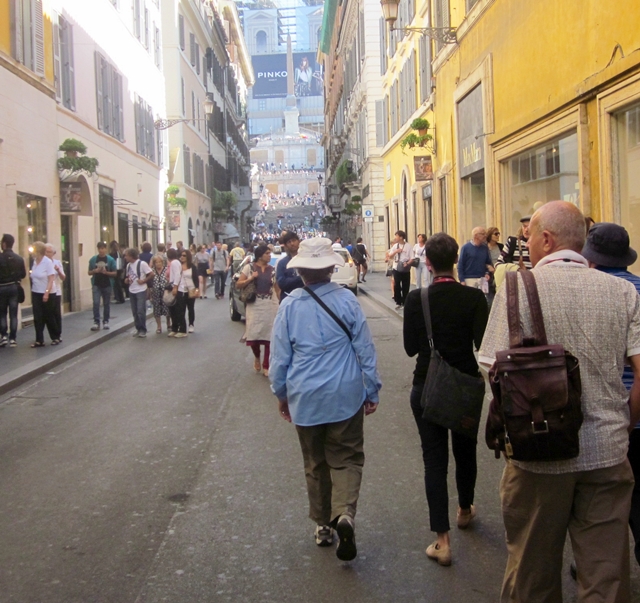 This is the Via Condotti. It is a busy and fashionable street of Rome. In Roman times it was one of the streets that crossed the ancient Via Flaminia and enabled people who crossed the Tiber to reach the Pincio hill. It begins at the foot of the Spanish steps and is named after conduits or channels which carried water to the Baths of Agrippa. Today, it is the street which contains the greatest number of Rome-based Italian fashion retailers: Dior, Gucci, Valentino, Hermès, Armani, Jimmy Choo, La Perla, Prada, Salvatore Ferragamo, Furla, Burberry, Céline, Dolce & Gabbana, Max Mara, Alberta Ferretti, Trussardi, Buccellati, Bulgari, Damiani, Tod’s, Cartier, Bally, Mont Blanc, and Louis Vuitton to name a few.
This is the Via Condotti. It is a busy and fashionable street of Rome. In Roman times it was one of the streets that crossed the ancient Via Flaminia and enabled people who crossed the Tiber to reach the Pincio hill. It begins at the foot of the Spanish steps and is named after conduits or channels which carried water to the Baths of Agrippa. Today, it is the street which contains the greatest number of Rome-based Italian fashion retailers: Dior, Gucci, Valentino, Hermès, Armani, Jimmy Choo, La Perla, Prada, Salvatore Ferragamo, Furla, Burberry, Céline, Dolce & Gabbana, Max Mara, Alberta Ferretti, Trussardi, Buccellati, Bulgari, Damiani, Tod’s, Cartier, Bally, Mont Blanc, and Louis Vuitton to name a few.
Mary Ann and Francesca kept their eyes focused on the Spanish Steps.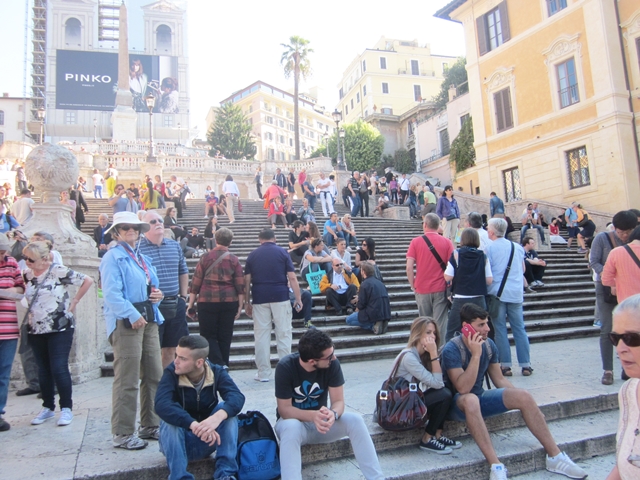 The Spanish Steps are a set of stairs climbing a steep slope between the Piazza di Spagna at the base and Piazza Trinità dei Monti at the top, dominated by the Trinità dei Monti church at the top.
The Spanish Steps are a set of stairs climbing a steep slope between the Piazza di Spagna at the base and Piazza Trinità dei Monti at the top, dominated by the Trinità dei Monti church at the top.
In the piazza, at the corner on the right is the house where English poet John Keats lived and died in 1821; it is now a museum dedicated to his memory.
The 1953 film “Roman Holiday”, starring Audrey Hepburn and Gregory Peck, made the Spanish Steps famous to an American audience. As you can see, the audience is still waiting for the stars to return. Or maybe they’re just students and/or slackers. 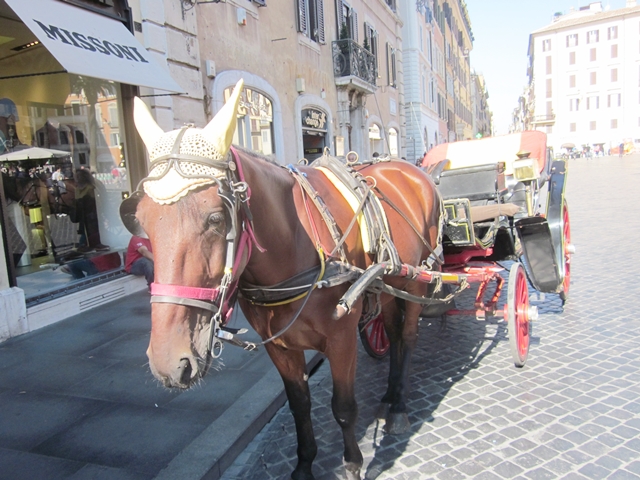 This fella with the fancy straw hat was taking in the sights at the Spanish Plaza. I think he’d seen them all before.
This fella with the fancy straw hat was taking in the sights at the Spanish Plaza. I think he’d seen them all before.
 A short walk from the top of the Spanish Steps lies the Villa Borghese. It is a large landscaped garden park in the naturalistic English manner. It, contains a number of buildings, museums. and attractions. It is the third largest public park in Rome (148 acres).
A short walk from the top of the Spanish Steps lies the Villa Borghese. It is a large landscaped garden park in the naturalistic English manner. It, contains a number of buildings, museums. and attractions. It is the third largest public park in Rome (148 acres).
This building is the Galleria Borghese. It houses a substantial part of the Borghese collection of paintings, sculpture and antiquities and is open to the public. However, tickets must be purchased in advance, so we missed the window here.
Mary Ann and I and a fellow tour lady had a nice lunch in the beautiful park with food “scavenged” (sandwiches made with bread, ham, salami, and cheese and fruit) from the breakfast buffet in our hotel. Our lunch view included seeing these “Pines of Rome”. They are quite distinctive with the soaring height and broad crowns. They are also called Umbrella Pines. Ottorino Respighi wrote a famous piece of music called coincidentally “The Pines of Rome”.
Our lunch view included seeing these “Pines of Rome”. They are quite distinctive with the soaring height and broad crowns. They are also called Umbrella Pines. Ottorino Respighi wrote a famous piece of music called coincidentally “The Pines of Rome”. There is something for everyone here. Including pony rides for the kids. After hanging out in the park all afternoon, we went back to our hotel to get ready for our “Rome by Night” evening drive.
There is something for everyone here. Including pony rides for the kids. After hanging out in the park all afternoon, we went back to our hotel to get ready for our “Rome by Night” evening drive.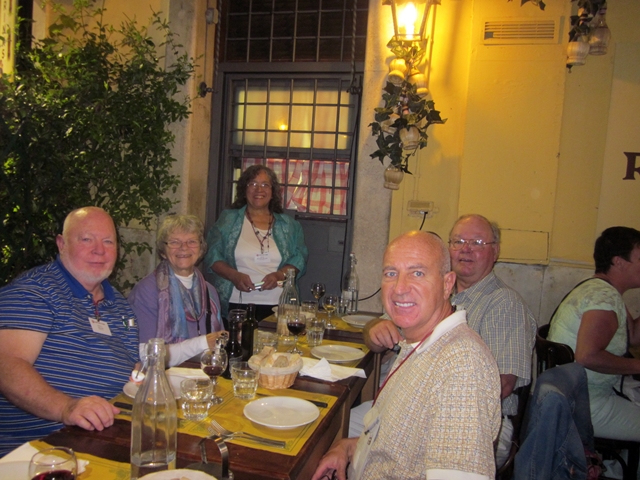 We went by bus to the Trastevere section of Rome and had dinner in the Cafe Rugantino . It’s across the Tiber from where we were staying. The food was excellent!! Those two scary looking guys are Tracy and Randy from Sebring, Florida. Tracy (on the left) kept our group laughing – he was a real clown. After dinner we walked around the area and watched the crowds at the Piazza Santa Maria.
We went by bus to the Trastevere section of Rome and had dinner in the Cafe Rugantino . It’s across the Tiber from where we were staying. The food was excellent!! Those two scary looking guys are Tracy and Randy from Sebring, Florida. Tracy (on the left) kept our group laughing – he was a real clown. After dinner we walked around the area and watched the crowds at the Piazza Santa Maria.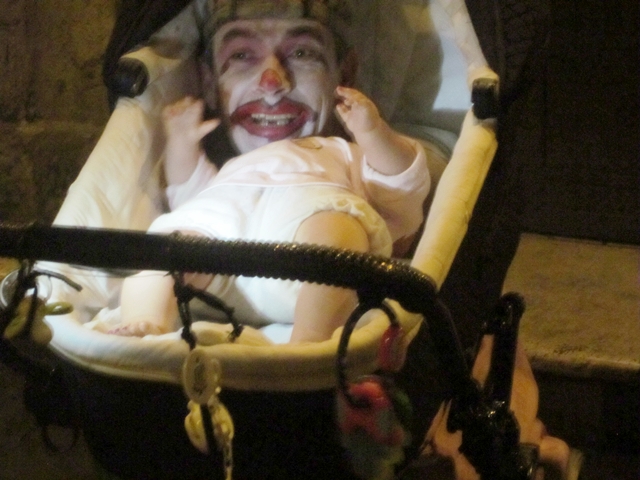 This baby in his carriage caught our eye.
This baby in his carriage caught our eye.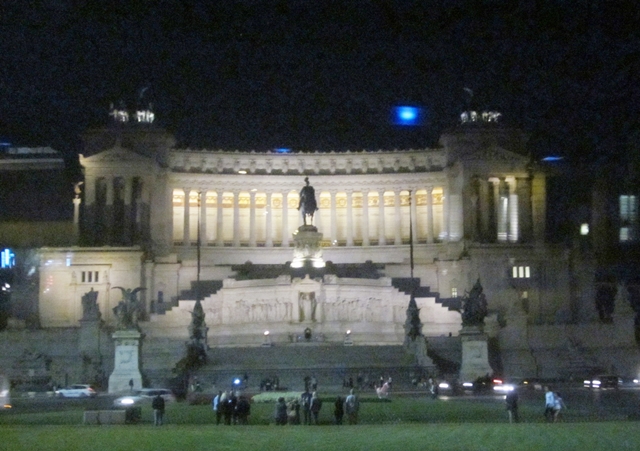 We drove around Rome after dark and Francesca pointed out some of the things we’d see in the daylight on our next day (like the Italian Reunification Monument). After the ride we crashed in our hotel bed for a night’s sleep. Perhaps to get ourselves into the Central European time zone.
We drove around Rome after dark and Francesca pointed out some of the things we’d see in the daylight on our next day (like the Italian Reunification Monument). After the ride we crashed in our hotel bed for a night’s sleep. Perhaps to get ourselves into the Central European time zone.
On our 2nd full day in Rome we took a bus with our small pre-trip group to the Colosseum and the Forum. This was another GCT “optional” excursion. It’s a little bewildering to think we paid a lot of dough for our Rome pre-trip and had to pay another amount for this excursion. Why else would we come to Rome, if not to tour places like Colosseum and the Forum? Why should they be extra cost? Did GCT think we flew to Rome just to sit in a cafe eating pasta and gelato? Anyway, enough ranting.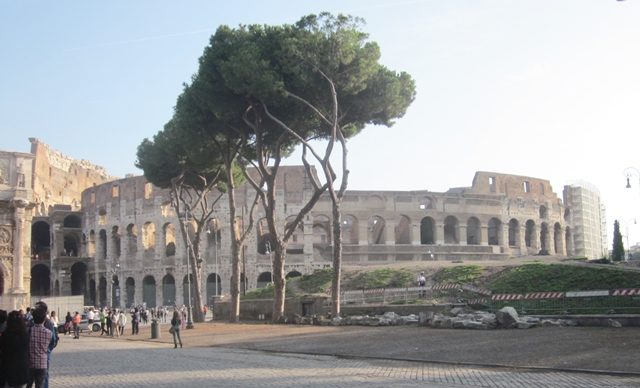 This was our first view of the Colosseum (AKA the Flavian amphitheater). It is one of the most imposing of the ancient Roman structures. Imagine it all white, completely covered in splendid travertine stone slabs (a form of limestone). It is elliptic in shape in order to hold more spectators. It had four floors; the first three had eighty arches each; the arches on the second and third floors were decorated with huge statues.
This was our first view of the Colosseum (AKA the Flavian amphitheater). It is one of the most imposing of the ancient Roman structures. Imagine it all white, completely covered in splendid travertine stone slabs (a form of limestone). It is elliptic in shape in order to hold more spectators. It had four floors; the first three had eighty arches each; the arches on the second and third floors were decorated with huge statues.
What we see nowadays is just the skeleton of what was the greatest arena in the ancient world. Three-fifths of the outer surrounding brick wall are missing. In the Middle Ages, when no longer in use, the Colosseum was transformed into an enormous marble, lead and iron quarry used by Popes to build the Barberini Palace, thePiazza Venezia and even St. Peter’s. (Note: The Pines of Rome.)  The holes still seen in many columns and walls are just the holes made to extract the lead and iron used by the Romans for the nails inside that held the marble blocks. Was this desrcration or urban renewal?
The holes still seen in many columns and walls are just the holes made to extract the lead and iron used by the Romans for the nails inside that held the marble blocks. Was this desrcration or urban renewal? This is an artists rendering of the construction of the Colosseum. Looking at the inside, starting from the right are the walls separating the galleries, then arches built on top of the walls, then the arches filled in and finally the stone “bleacher” seats.
This is an artists rendering of the construction of the Colosseum. Looking at the inside, starting from the right are the walls separating the galleries, then arches built on top of the walls, then the arches filled in and finally the stone “bleacher” seats.
Construction of the Colosseum began under the rule of Emperor Vespasian in 72 AD. It was completed by his son, Titus, in 80 AD. A total of 8 years. If one adds the slaves that were making bricks or working in the quarries to cut the stones, there were gets at least 20,000 to 30,000 people involved. The two underground floors housed the lifts and hoists with their counter weights, of which we can still see the rails today; they were the special effects of the time, used to hoist up animals and gladiators who burst into the arena through trapdoors, suddenly appearing in a burst of white dust giving the audience great surprise effects.
The two underground floors housed the lifts and hoists with their counter weights, of which we can still see the rails today; they were the special effects of the time, used to hoist up animals and gladiators who burst into the arena through trapdoors, suddenly appearing in a burst of white dust giving the audience great surprise effects.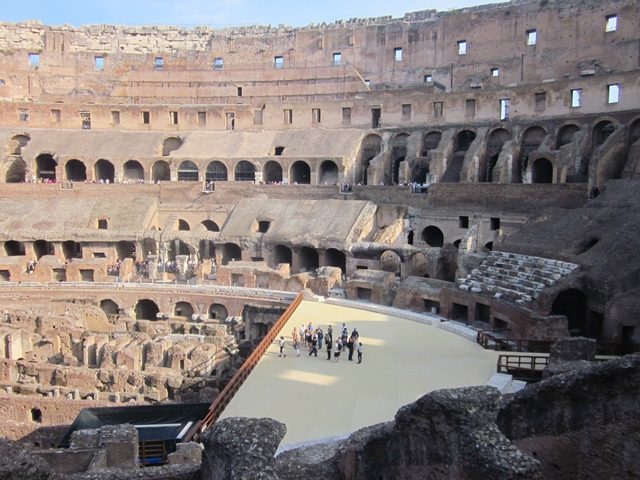 A bit of the floor and bleachers (seats) have been restored. to show the sand (arena) that was the site of the action.
A bit of the floor and bleachers (seats) have been restored. to show the sand (arena) that was the site of the action. Just like today, there is always as much action in the stands as in the arena!
Just like today, there is always as much action in the stands as in the arena!
 Here is our Colosseum and Forum guide. I’ve misplaced her name, but I remember the excellent job she did guiding us through the crowds and explaining everything.
Here is our Colosseum and Forum guide. I’ve misplaced her name, but I remember the excellent job she did guiding us through the crowds and explaining everything.
A few comments about the Colosseum: The amphitheater could hold up to seventy thousand spectators. The tiers of seats were inclined in such a way as to enable people to get a perfect view from wherever they sat.
Entry was free for all Roman citizens, but places were divided according to social status, similar to seating divisions in today’s theaters; the seats at the top were for the common people, but with distinct sections for men and women, the nearer you got to the arena the higher your social status; in the front row were senators, vestals, priests and – naturally – the emperor.
Like modern sports stadiums, the Colosseum gave spectators efficient protection from the sun thanks to its ingenious roof covering called the “Velarium”. It was an enormous linen tarpaulin hung by a system of ropes, winches and wooden poles that girded the top of the outer wall. It took one hundred sailors from the Imperial fleet to move it. They moved in perfect synchrony to the beating of a drum.
Lots of different shows were put on in the amphitheater, at different times, following a specific time schedule:
In the morning the “Venationes” – fights between exotic animals, or between men and animals. At times, as a form of public execution, people were left to the mercy of ferocious beasts. Called the “Silvae”. it must have been quite spectacular. Special scenery was constructed in the arena by painters and set-designers, with trees and bushes, so that it looked like a forest full of animals, which in this case did not necessarily have to be killed.
But also less cruel and definitely more unique events took place like the famous exhibition of an elephant who knew how to write words in the sand with its trunk. It is not true that the Colosseum was used to kill Christians as a kind of spectacle. The event the audience enjoyed most was definitely the gladiators. Towards midday there was a break during which they removed the bodies and spread more sand on the arena floor.
The event the audience enjoyed most was definitely the gladiators. Towards midday there was a break during which they removed the bodies and spread more sand on the arena floor.
A deafening noise arose from the audience; to the blaring of trumpets and the beating of drums, the gladiators triumphantly paraded into the packed arena.
They came from an underground passageway linked directly to the Gladiators’ barracks, and were welcomed by fans like real heroes, a bit like today’s sports champions. After a brief walk around the arena, the gladiators paid homage to the Emperor’s stage saluting with the famous words “Ave Cesare morituri te salutant” (Hail Caesar, those who are about to die salute you).
The winners received golden palm leaves and large amounts of money. After each battle, servants dressed like Charon, the Ferryman of the Underworld, made sure that the wounded were really dead and where necessary finished them off. The gladiator’s blood was much in demand; people thought it had healing powers and could heal you from epilepsy and give you greater sexual vigor.
Roman spectators loved cruel shows, those that we consider violent to say the least. Their passion for these events can be compared to what some people nowadays feel for the so-called “splatter” cinema. With one basic difference: the crudeness of reality. Just think that during mass battles and in the hunts, the smell of blood and burnt flesh and that of wild animals became unbearable and the effort to mask it with incense and perfumes had no effect whatsoever.
Let’s leave the Colosseum.  Outside the Colosseum is St Constantine’s Arch. This Triumphal Arch was dedicated in AD 315 to celebrate Constantine’s victory three years before over his co-emperor, Maxentius.
Outside the Colosseum is St Constantine’s Arch. This Triumphal Arch was dedicated in AD 315 to celebrate Constantine’s victory three years before over his co-emperor, Maxentius.
Constantine claimed he owed his victory to a vision of Christ, but there is nothing Christian about the arch – in fact, most of the medallions, reliefs and statues were scavenged from earlier monuments. There are statues of Dacian prisoners taken from Trajan’s Forum and reliefs of Marcus Aurelius, including one where he distributes bread to the poor. This is about all that’s left of the Roman Forum. (And, no, that’s not me in the lower left.)
This is about all that’s left of the Roman Forum. (And, no, that’s not me in the lower left.)
The Forum is a rectangular forum (plaza) surrounded by the ruins of several important ancient government buildings at the center of the city of Rome. Citizens of the ancient city referred to this space, originally a marketplace, as the Forum Magnum, or simply the Forum.
It was for centuries the center of Roman public life: the site of triumphal processions and elections; the venue for public speeches, criminal trials, and gladiatorial matches; and the nucleus of commercial affairs. Here statues and monuments commemorated the city’s great men. The teeming heart of ancient Rome, it has been called the most celebrated meeting place in the world, and in all history. Located in the small valley between the Palatine and Capitoline Hills, the Forum today is a sprawling ruin of architectural fragments and intermittent archaeological excavations attracting 4.5 million sightseers yearly.
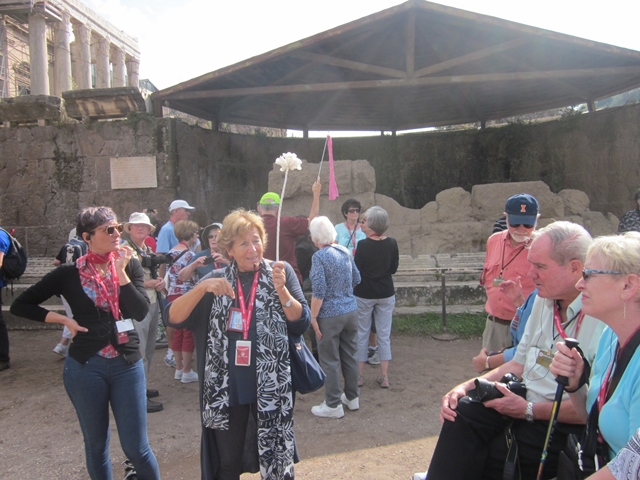 This is one interesting spot in the Forum. In this shed is the actual (so they say) site of Julius Caesar’s funeral pyre. Contrary to ledgend, he was not slain here in this Forum, but at another political site a short distance away (Picture to follow.). Our guide is describing things to Bob and Elva from Bellingham, WA. Francesca is scanning for her lost flock of tourists.
This is one interesting spot in the Forum. In this shed is the actual (so they say) site of Julius Caesar’s funeral pyre. Contrary to ledgend, he was not slain here in this Forum, but at another political site a short distance away (Picture to follow.). Our guide is describing things to Bob and Elva from Bellingham, WA. Francesca is scanning for her lost flock of tourists.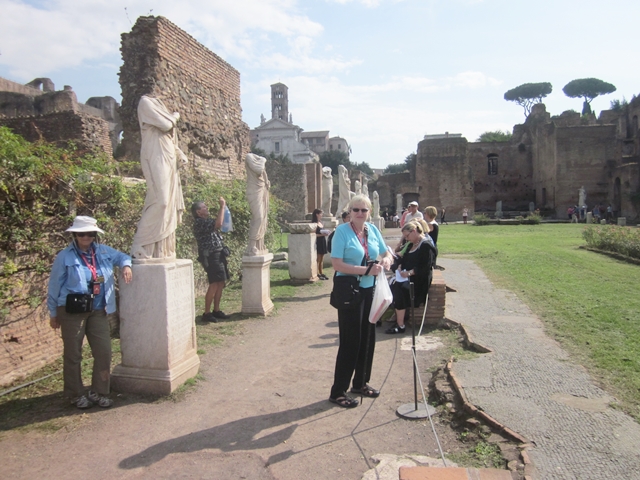 This was the garden of the Vestal Virgins. In ancient Roman religion, the Vestals or Vestal Virgins were priestesses of Vesta, goddess of the hearth. The College of the Vestals and its well-being was regarded as fundamental to the continuance and security of Rome. They cultivated the sacred fire that was not allowed to go out. The Vestals were freed of the usual social obligations to marry and bear children, and took a vow of chastity in order to devote themselves to the study and correct observance of state rituals that were off-limits to the male colleges of priests.
This was the garden of the Vestal Virgins. In ancient Roman religion, the Vestals or Vestal Virgins were priestesses of Vesta, goddess of the hearth. The College of the Vestals and its well-being was regarded as fundamental to the continuance and security of Rome. They cultivated the sacred fire that was not allowed to go out. The Vestals were freed of the usual social obligations to marry and bear children, and took a vow of chastity in order to devote themselves to the study and correct observance of state rituals that were off-limits to the male colleges of priests.
Sorry Guys, you’ll have to stick to altar boys. We did a lot of walking around the ruins of the Forum and learned a lot more ancient Roman history including that this road was the Appian Way. A lot of it was paved with basaltic rock from Mt Vesuvius.
We did a lot of walking around the ruins of the Forum and learned a lot more ancient Roman history including that this road was the Appian Way. A lot of it was paved with basaltic rock from Mt Vesuvius.
The Via Appia, originally built in 312 BC, was the brainchild of Appius Claudius Caecus, the then-censor of Rome. The road began as a level dirt surface upon which mortar and small stones were laid. On top of that, gravel was placed, topped with interlocking stones that would provide a flat surface.
Near Rome the road was lined with tombs. Since it was forbidden to bury the dead in the city proper, many were buried along the roads leading out of Rome. Important people built tombs for themselves or for their whole family. Sometimes these tombs were as large as a house.
The Via Appia was lined with such monuments and many of them are still visible today. Besides the numerous tombs along the road, there are some other monuments that line the Via Appia: the Temple of Hercules and the church Quo Vadis (where Saint Peter is said to have met Christ).
While the Via Appia is lined with monuments and tombs of ancient Roman patrician families, many find what’s under the Appian Way to be more interesting. Below the street are miles of tunnels – known as catacombs – where the early Christians buried their dead and, when necessary, held secret church services. Several of the catacombs are open to the public.
Spartacus (the slave) led a revolt and defeated many Roman armies in a conflict that lasted for over two years. While trying to escape from Italy at Brundisium he unwittingly moved his forces into the historic trap in Apulia/Calabria. The Romans were well acquainted with the region. Legions were brought home from abroad and Spartacus was pinned between armies.
On his defeat the Romans judged that the slaves had forfeited their right to live. In 71 BC, 6,000 slaves were crucified along the120 mile Via Appia from Rome to Capua. One final view of ancient Rome. We hired a helicopter and flew back 2,000 years to see what Rome looked like. We could see the splendid white marble of the Colosseum, the colonnaded buildings of the Forum to its left and the Temple and Gardens of the Vestal Virgins to the right. It was quite a sight!!
One final view of ancient Rome. We hired a helicopter and flew back 2,000 years to see what Rome looked like. We could see the splendid white marble of the Colosseum, the colonnaded buildings of the Forum to its left and the Temple and Gardens of the Vestal Virgins to the right. It was quite a sight!!
Just above the Colosseum is a bit of what looks like the a colosseum. It’s the training school for gladiators (the “Ludi Gladiatorium”). A tunnel connected it to the cellar of the Colloseum across the street.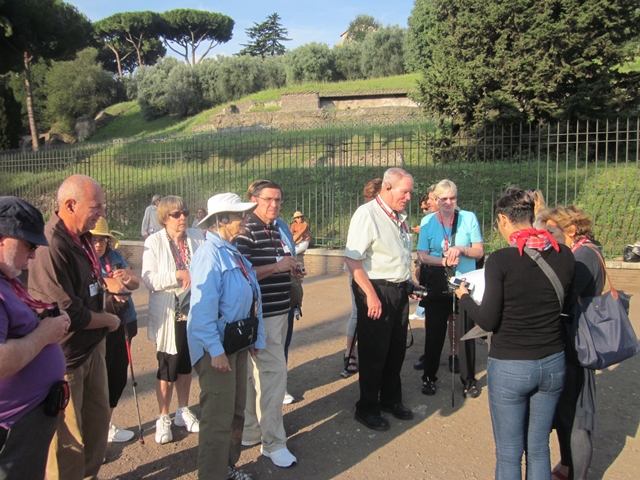 The tour group gathered and reboarded the bus, with Francesca counting noses, to go back to the hotel for a “GCT lunch on your own and free time” afternoon. Mary Ann and I went as with them as far as the Piazza Venezia. From there, (after enjoying one of scavenged lunches) we took off on our own.
The tour group gathered and reboarded the bus, with Francesca counting noses, to go back to the hotel for a “GCT lunch on your own and free time” afternoon. Mary Ann and I went as with them as far as the Piazza Venezia. From there, (after enjoying one of scavenged lunches) we took off on our own.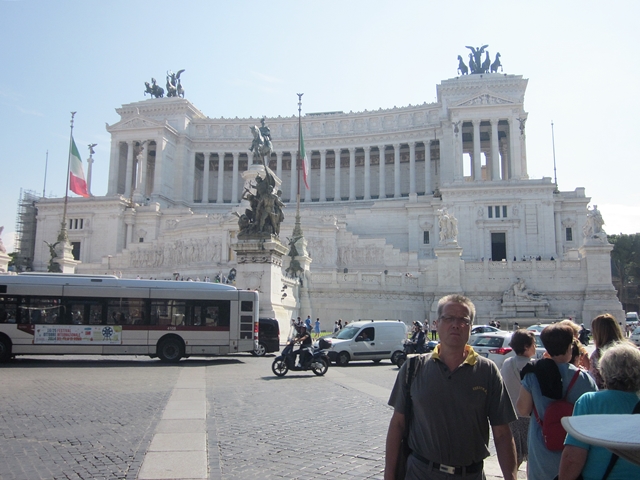 We saw this monument last night. Its the Monument to Vittorio Emanuele II, first king of Italy and is also known as the Altar of the Fatherland.Also known as The Vittoriano. It features the Tomb of the Unknown Soldier stairways, Corinthian columns, fountains, an equestrian sculpture of Victor Emmanuel and two statues of the goddess Victoria riding on quadrigas (4 horses). As similar quadriga is on the Brandenburg Gate in Berlin.
We saw this monument last night. Its the Monument to Vittorio Emanuele II, first king of Italy and is also known as the Altar of the Fatherland.Also known as The Vittoriano. It features the Tomb of the Unknown Soldier stairways, Corinthian columns, fountains, an equestrian sculpture of Victor Emmanuel and two statues of the goddess Victoria riding on quadrigas (4 horses). As similar quadriga is on the Brandenburg Gate in Berlin.
The monument, the largest in Rome, was controversial since its construction, in 1911 to 1925.It destroyed a large area of the Capitoline Hill with a Medieval neighborhood. The monument itself is often regarded as conspicuous, pompous and too large.
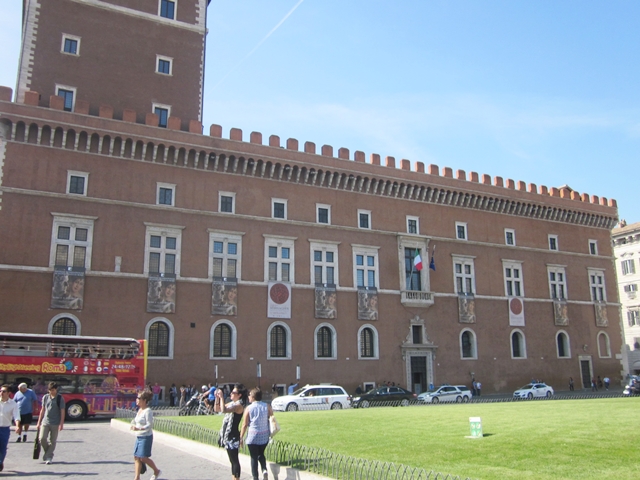 Looking down from Il Vittoriano towards Piazza Venezia, you can see the Palazzo Venezia on your left. The building that gave the square its name was built between 1455 and 1464 by cardinal Pietro Barbo who went on to become pope Paul II. It is one of the oldest civil Renaissance buildings in Rome.
Looking down from Il Vittoriano towards Piazza Venezia, you can see the Palazzo Venezia on your left. The building that gave the square its name was built between 1455 and 1464 by cardinal Pietro Barbo who went on to become pope Paul II. It is one of the oldest civil Renaissance buildings in Rome.
The palace was used as a papal residence until pope Pius IV handed the building over to Venice, who used it as their embassy. In 1916 the Palazzo Venezia was acquired by the Italian government. Benito Mussolini used the building as his headquarter and addressed the people from the palace’s balcony.
I have seen newsreels of Mussolini orating to the crowds from the window with the flag above the main door so I was especially pleased to see it for real. The Largo di Torre Argentina is a square in Rome, Italy, that hosts four Republican Roman temples, and the remains of Pompey’s Theater.
The Largo di Torre Argentina is a square in Rome, Italy, that hosts four Republican Roman temples, and the remains of Pompey’s Theater.
Julius Caesar was killed in the Curia of the Theater of Pompey A curia was a designated structure for meetings of the senate, and the spot he was believed to be assassinated is in the square on the stairs seen here.
Also located here is the Torre Argentina Cat Sanctuary, a no-kill shelter for homeless cats (of which Rome has many), as the historical area abounds with various breeds of cats. The cat sanctuary had been requested to close due to perceived health concerns, but remains open as of October 2014. We then walked to the Pantheon. It was tucked into a densely packed neighborhood of residential and commercial buildings as can be seen from our helicopter shot. I’m going to tell you more about the Parthenon than you may want know, but I’m going to do it anyway. I think you’ll find it fascinating.
We then walked to the Pantheon. It was tucked into a densely packed neighborhood of residential and commercial buildings as can be seen from our helicopter shot. I’m going to tell you more about the Parthenon than you may want know, but I’m going to do it anyway. I think you’ll find it fascinating.
The word Pantheon is a Greek adjective meaning “honor all Gods”. In fact the pantheon was first built as a temple to all gods.
It is the best preserved Ancient Roman monument. The structure itself is way ahead of its time. In fact, the exact composition of the material is still unknown and appears to be structurally similar to modern day concrete! Whatever the reasons are, the Pantheon is the only structure of its age and size that has successfully survived the damage of time and gravity, still intact with all its splendor and beauty.
The Pantheon as we know it today was built in 120 AD by Emperor Hadrian who was passionate with architecture and designed it together with Apollodorus of Damascus, a famous Greek architect of the time who unfortunately was executed by order of the Emperor, because of an argument about the design of the temple.
The most fascinating part of the Pantheon is its giant dome, with its famous hole in the top (The eye of the Pantheon, or oculus). The dome was the largest in the world for 1300 years and until today it remains the largest unsupported dome in the world! The diameter of the dome is 142 feet (for comparison, the United States Capitol dome is 96 feet in diameter) and is in perfect proportion with the Pantheon by the fact that the distance from the floor to the top of the dome is exactly equal to its diameter.
The great architectural achievement was due to the massive weight of the large dome. Roman engineers lightened the dome as much as possible; not only its thickness progressively decreases, but the materials used in the upper part of the dome were lighter with internal spaces within the dome walls. The decrease in thickness has the effect that while the interior of the ceiling is spherical, its exterior is slightly “flattened”. It is larger than the dome of St. Peter’s basilica but since it seems flattened from the outside it is hard to get a full sense of its dimension.
The hole (oculus), 26 feet in diameter, is the only source of light and is the connection between the temple and the gods above. Rain occasionally fall through it, but the floor is slanted and drains the water if it manages to hit the floor. In practice, rain seldom falls inside the dome.
The Pantheon now contains the tombs of the famous artist Raphael and of several Italian Kings and poets. The marble floor, which features a design consisting of a series of geometric patterns, is still the ancient Roman original.
The history of Pantheon was forever changed during the reign of Pope Urban VIII (nee Barberini). Around 1630 he caused the melting down every scrap of bronze located upon the ceiling, outraging a great deal of Roman citizens. The bronze was use to create the huge alter columns in St Peters Basillica.
The 16 massive Corinthian columns supporting the portico weigh 60 tons each. They are 39 feet tall, five feet in diameter and brought all the way from Egypt. These columns were dragged more than 60 miles from the quarry to the Nile river on wooden sledges. They were floated by barge down the Nile River when the water level was high during the spring floods, and then transferred to vessels to cross the Mediterranean Sea to the Roman port of Ostia. There, they were transferred back onto barges and pulled up the Tiber River to Rome. All this in 1200 AD!!
The Columns support a triangle pediment with an inscription attributing the Pantheon to Marcus Agrippa (“M•AGRIPPA•L•F•COS•TERTIUM•FECIT” meaning “It was built by Marcos Agrippa in his third consulate”). It is the only remains from the original temple built by Agrippa and it is believed that Hadrian left it as a gesture to his predecessor when he rebuilt the pantheon.
A lighting effect can be viewed on April 21 when the midday sun strikes a metal grille above the doorway, saturating the courtyard outside with light.
The Romans celebrated April 21 as the founding date of the city, and the impressive sight of their Emperor Hadrian standing at the entrance of the Pantheon surrounded by light coming from inside the pantheon might have been seen as something that, in effect, raised their emperor to the level of the gods and invited him in to join them.
In the year 609 The Pantheon was the first pagan temple to be transformed into a church and therefore it was saved from being destroyed during the middle Ages. Today it is a church dedicated to St. Mary of the Martyrs. None the less it is called the Pantheon by virtually everybody and it seems to exist independent of religious rule but more of a tribute to the past.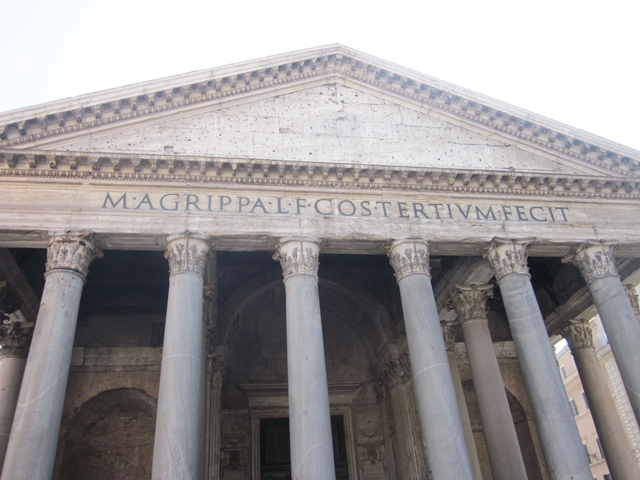
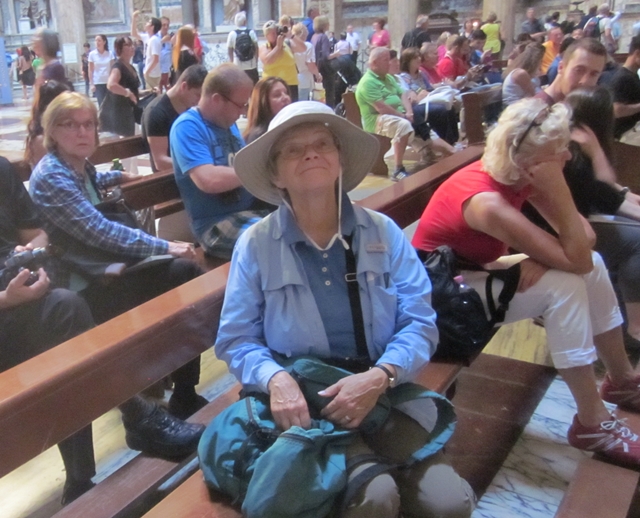 That’s it for the Pantheon.
That’s it for the Pantheon. 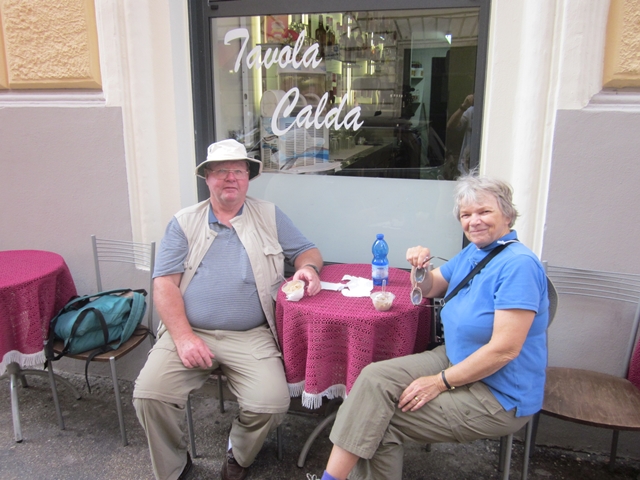 We hiked back to the hotel, had a gelato, took a rest, and went back to the San Marco restaurant for dinner. Eggplant pizza and red wine. Yum! Yum!
We hiked back to the hotel, had a gelato, took a rest, and went back to the San Marco restaurant for dinner. Eggplant pizza and red wine. Yum! Yum!

